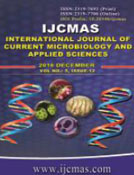


 National Academy of Agricultural Sciences (NAAS)
National Academy of Agricultural Sciences (NAAS)

|
PRINT ISSN : 2319-7692
Online ISSN : 2319-7706 Issues : 12 per year Publisher : Excellent Publishers Email : editorijcmas@gmail.com / submit@ijcmas.com Editor-in-chief: Dr.M.Prakash Index Copernicus ICV 2018: 95.39 NAAS RATING 2020: 5.38 |
After cellulose; lignin is the most abundant renewable carbon source on Earth and very resistant to degradation. In present study isolation and characterization of ligninolytic bacteria were done from Kuthrel agro-fields of Bhilai-Durg regions. Isolation of microbes was done from both mixed and black soil samples by Hungate method. Result shown that four types of bacterial colonies (2-MS, 2-BS) were isolated from agro field. Out of these only 2 types of colonies were shown potential of lignin degradation. The Morphological, biochemical characteristics of the isolates were identified (H)-Bacillus sp. and (h) – Streptomyces sp. with reference to Bergey’s Manual of Determinative Bacteriology. These identified isolates Bacillus sps. and Streptomyces sps. were found to have the potential to tolerate high concentrations of kraft lignin and produced all three main ligninolytic enzymes (lignin peroxidase, manganese peroxidase, and laccase). These enzymes were quantified in 2 bacterial strains evaluated at pH 7.4 (LiP = veratryl alcohol-guaiacol; MnP = lactate-guaiacol-Mn+2; laccase = ABTS-catalase). From these, two strains (Bacillus species and Streptomyces species) showed the most activity for Li peroxidase strains Bacillus species and Streptomyces species also had the greater activity for Mn peroxidase and Laccase. This result concluded that both kinds of strains were able to degrade lignin substrate and have specific advantages for the depolymerization of the modified lignin residues typically encountered in waste streams from the pulping or 2nd generation biofuel/biobased chemicals industry.
 |
 |
 |
 |
 |